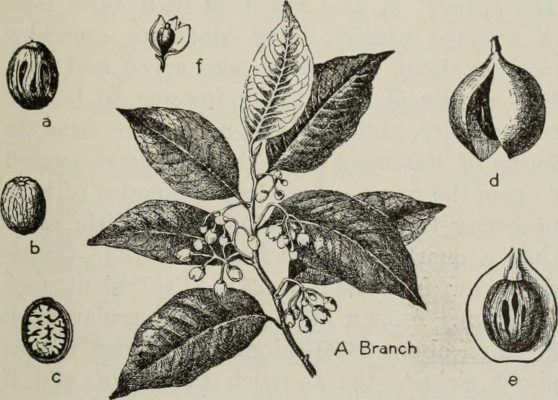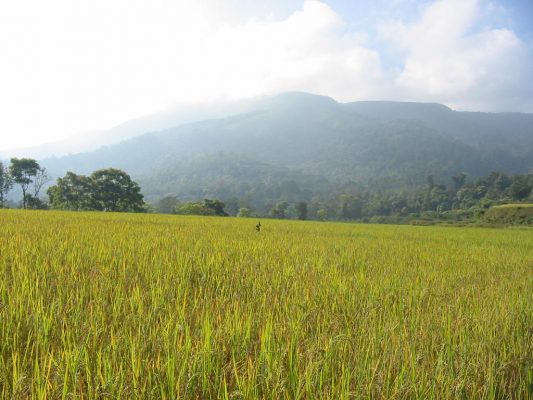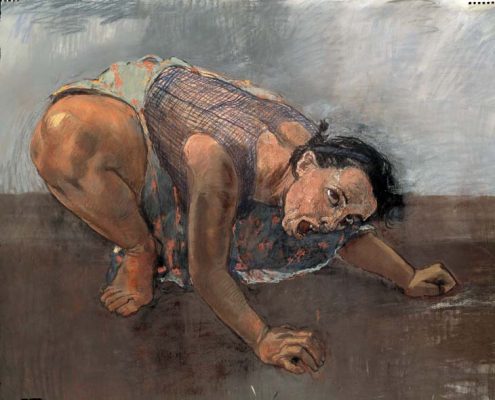At the end of Amitav Ghosh’s SEA OF POPPIES (2008), a character reflects on how her life has been governed not by the sign of Saturn but by the poppy seed. Offering a seed to her lover, she says: ‘Here, taste it. It is the star that took us from our homes and put us on this ship. It is the planet that rules our destiny.’ SEA OF POPPIES is part of the Ibis trilogy by Ghosh – followed by RIVER OF SMOKE (2011) and FLOOD OF FIRE (2015) – about the nineteenth-century Anglo-Chinese Opium Wars. The maritime novels use opium as a vector for unlikely alliances among a disparate cast of characters: Deeti, a widowed poppy farmer; Ah Fatt, a half-Chinese, half-Parsi convict and opium addict; Neel Rattan Halder, a bankrupt Indian landowner; Zachary Reid, a white-passing opium trader; and a multitude of other lascars and indentured servants in the Indian Ocean. Each novel dramatises opium’s vast powers: to stupefy the senses, domesticate people into docility, engender hallucinations and create loopholes in linear time. Personal boundaries become porous as opium encourages characters to flout caste delineations, binding them in improbable intimacies; bringing them face to face with the uncanny power of the nonhuman, or what the Enlightenment notion of history has grouped together under the umbrella of ‘nature’. With each book, Ghosh builds up a world teeming with energy – a world where opium is not mute but mutable.
‘This minuscule orb – at once bountiful and all-devouring, merciful and destructive, sustaining and vengeful.’ This is how Deeti, in SEA OF POPPIES, comes to think of the capricious poppy seed, which has dealt her both good and bad fortune. Her description serves just as well for the nutmeg, another commodity that has been prized as a fillip for foodies and, on the other side of the ledger, precipitated bloody conflicts in places like the Banda Islands, located on the southeastern tip of present-day Indonesia. It is the nutmeg that lends its name to Ghosh’s new work of nonfiction and serves as its central protagonist.
THE NUTMEG’S CURSE is, in many ways, a follow-up to THE GREAT DERANGEMENT, a series of lectures Ghosh gave in 2015 about the widening gyre of climate catastrophe and the narrowness of literary responses to it. In it, he locates modernity’s ‘derangement’ in its refusal to recognise ‘that we have always been surrounded by beings of all sorts who share elements of that which we had thought to be most distinctively our own: the capacities of will, thought, and consciousness.’ It’s this kernel of insight that Ghosh returns to in THE NUTMEG’S CURSE. (One might say there’s a way in which each of his books proleptically begets the next, spiraling from poppy seeds, to global warming, to nutmeg.) If THE GREAT DERANGEMENT casts mainland Asia as ‘both protagonist and victim’ of the climate crisis, in Ghosh’s new book, the role of protagonist is supplanted by the nutmeg. THE NUTMEG’S CURSE is both an unauthorised biography of the spice and a call to reanimate our politics in a way that respects the agency or ‘vitality’ of non-human beings all around us.
THE NUTMEG’S CURSE begins in medias res. The year is 1621 and the setting is a clutch of volcanic islands in the Banda Sea. One of the islands, Run, was traded by the British to the Dutch for Manhattan in the seventeenth century. The British legacy included an obsession with nutmeg, a fragrant spice, which in 1621, was worth more than gold. It makes for a heady contrast: a swampy island in New Amsterdam becomes a global trade centre, while a speck in an archipelago three kilometres long comes to be associated almost exclusively with a small but incredibly valuable nut.
When the Dutch first travel to Banda, they think the islands are the only place in the world with tropical nutmeg trees. Tensions soon begin to simmer between the Dutch East India Company – the Vereenigde Oostindische Compagnie, or the VOC – and the Bandanese. The Bandanese had formerly been organised into small, democratic city states, negorij, that recognised the autonomy of free citizens, who exercised their political influence in village assemblies. Ghosh explains how the decentralised power structure meant that even the more affluent Bandanese leaders, known as the orang-kaya, a Malay word meaning ‘men of wealth’, had little control over the Banda colony as a whole. As much as they tried, the VOC could not impose total domination over the Bandanese, who were skilled traders, and brokered treaties between the VOC and orang-kaya, or surreptitiously traded with other merchant communities across the Indian Ocean.
As Ghosh relays, one man in particular, governor-general Jan Pieterszoon Coen, had been nursing a grudge against the Bandanese ever since a treaty negotiation in 1609 turned into an ambush. Coen managed to escape, but 46 Dutchmen were killed. 12 years after that episode, conflicts between the VOC and Bandanese reach a boil. One May morning in 1621, Dutch forces and some eighty Japanese ronin, masterless samurai, are ordered by Coen to kill the ‘incorrigible’ Bandanese and ‘burn everywhere their dwellings’. Coen’s avowed intention is to bring ‘complete tranquility’ to the Banda Islands, by which he means: make way for VOC-approved settlers and establish a more subservient workforce for a monopolistic entrepôt of mace and nutmeg. The attack continues for several weeks and leads to the death of 44 orang-kaya, whose severed heads are set out on stakes. It is the prelude to a genocide of the island’s inhabitants that will stretch to the end of the year. Out of a population of 15,000 only hundreds survive. Of those, many either jump off cliffs to resist enslavement or are exiled to the trade center, Batavia.
After the massacre, to facilitate the large-scale production of nutmeg, the Dutch remake the Banda Islands into one of the first modern plantation economies built on the backs of slaves. Enslaved Bandanese, kept alive to teach the Dutch how to cultivate nutmeg, are malnourished, poorly treated and forced to constantly work to meet the demands of merchant capitalism. Encoded in this brutal treatment of the Bandanese is a proto-mechanistic worldview, one that views the Earth as a machine and humans as cogs. As Ghosh puts it, ‘It was the rendering of humans into mute resources that enabled the metaphysical leap whereby the Earth and everything in it could also be reduced to inertness.’ This violent reduction had both epistemic and corporeal implications. From 1621 to 1681, the Bandanese population declined from several hundred to slightly more than one hundred. As Dutch economist J.L. van Zanden has written in THE RISE AND DECLINE OF HOLLAND’S ECONOMY, by the start of the eighteenth century, the VOC had altogether eliminated the Bandanese from their census. (The Company kept meticulous records not only of the population of island groups, but also the number of clove and nutmeg trees, to assess the size of harvests and to adjust supply according to demand.)
The VOC went to extreme lengths to sell nutmeg at favourable prices, going so far as to order the destruction of nutmeg trees on more than a thousand islands to artificially keep supply low. This all-consuming zeal, for Ghosh, is emblematic of ‘an excess that leads ultimately not just to genocide but an even greater violence… “omnicide”, the desire to destroy everything.’ He notes that the VOC carried out its policy of extirpation for over a century, ‘with an obsession that appears, in retrospect, distinctly unhinged.’ The monomania of the mercenaries also manifested something else: ‘an inherent instability to the framework of world-as-resource that impels it to devour that which it enframes.’ Put another way, if everything keeps getting ‘disrupted’, to use a technocratic term, one day, there will be nothing left to disrupt. As it turned out, after the Napoleonic wars, the British seized control of the Banda Islands and contrived to plant nutmeg seedlings in other hospitable places, dislodging Banda from its perch at the top of the nutmeg totem. But a greater supply of spices caused prices to plummet, and Europe’s enthusiasm for nutmeg waned as tobacco, coffee and tea made their way into continental diets.
What often gets left out of chronicles about the Banda Islands, of which there are not many to begin with, are the perspectives of Bandanese survivors of the 1621 genocide, and their efforts to remember the past through stories and song. As Ghosh writes, ‘the modern gaze sees only one of the nutmeg’s two hemispheres… [it] is merely an inert object, a planet that contains no intrinsic meaning, and no properties other than those that make it a subject of science and commerce.’ THE NUTMEG’S CURSE shows us the hemisphere cast in a penumbra. Throughout the book, the chiaroscuro effect is extended to certain words as well, like ‘nature’, whose Western conception, Ghosh observes, ‘is the key element that simultaneously enables and conceals the true character of biopolitical warfare.’ The Bandanese have a very different relationship to nature, they view their islands as ‘places of dwelling that were enmeshed with human life in ways that were imaginative as well as material.’ Ghosh quotes the Indigenous thinker Max Liboiron, for whom land is ‘the unique entity that is the combined living spirit of plants, animals, water, humans, histories, and events.’ This is a ‘vitalist’ way of seeing the world that recognises the agency of material things. It’s also a view that any reader of Ghosh’s work implicitly senses. For those new to his writing, THE NUTMEG’S CURSE is not just a ‘parable for planetary crisis’, but also, albeit to a lesser extent, a kind of onboarding manual for his Ibis triple-decker.
Ghosh’s writing is animated by a question: given the long tail of European colonisation and its legacies of structural violence, is a paradigm shift possible today? For centuries, ‘vitalism’, or ‘animism’, the idea that ‘humans are not the only ensouled beings’ has been a red-headed stepchild of the scientific community. Ghosh remarks that for nineteenth-century men of science ‘to believe that the Earth was anything more than an inanimate resource was to declare oneself a superstitious savage – and that, in turn, was tantamount to placing oneself on the waiting list for extinction or extermination. Vitalism, savagery, and extinction were a series in which each term implied the next.’ Even today, merely to invoke the name Gaia, the Greek goddess of the Earth, is to court suspicion, if not derision, in some circles. The power to name things is, of course, not an innocent project; it is imbricate with empire. In a fascinating section, Ghosh shows how the Linnaean system of nomenclature – for instance, calling the nutmeg tree Myristica fragrans – rendered all living things ‘comparable so that they could be turned into ‘useful resources’’.
To move beyond a ‘mechanistic metaphysic’ is to treat nutmeg, cloves, mace and sugarcane not as inert, pliant resources or commodities waiting to be used by humans, but rather as products of the Earth closely enmeshed with humanity, endowed perhaps with ‘world- or history-making powers of their own’. This is the antithesis of apocalyptic visions of ‘omnicide’. To get there, Ghosh suggests, we need, at minimum, to reckon with settler colonialism, which wends its way through the gullet of our globe like a deadly time-release drug. The Banda massacre of 1621, Ghosh writes, ‘was a fast-forwarded version of a history that would unfold at a slower pace in many other parts of the world. The global hierarchies that were then put in place persisted well into modern times, and were in many ways constitutive of modernity.’ We have never not been modern, it seems, as colonisation and conquest go hand in glove. Ghosh points out that whether practiced in the Canary Islands, Ireland or the Americas, settler colonialism radically refashioned physical landscapes and contributed to ‘planet-wide climatic disruptions’. Terraforming, or the transformation of land by settler colonisers, is war by another name: historically, it has had disastrous consequences for native inhabitants, who saw their land get reengineered to suit the rapacious desires of (usually European) conquerors. A vitalist politics as Ghosh sees it refuses to engage in colonising or subjugating processes, with all the ‘biopolitical conflicts’ and ‘ecological disruptions’ that they entail. It asks instead: what new forms of awareness can be attained from enlarging our empathy and listening to the stories of things around us?
Ghosh offers plenty of yeasty details to make his story rise. One node of vitalism, for instance, can be found in the work of Indigenous thinkers and shamans. In a chapter called ‘The Falling Sky’ Ghosh discusses a text of the same name co-written by the Yanomami shaman Davi Kopenawa and French anthropologist Bruce Albert. Growing up in the Amazon basin, Kopenawa witnessed the ravaging of Yanomami land by settlers and disease. In the 1980s, he joined with Albert to repel gold prospectors who were invading Brazil’s rain forests and killing Indigenous peoples. Kopenawa’s political acts signaled, for Ghosh, ‘a rebellion against the processes of muting’ that are the hallmarks of extractivist colonial practices. Such processes for Ghosh are tantamount to ‘subjugating… an entire universe of beings that was once thought of as having agency, powers of communication, and the ability to make meaning – animals, trees, volcanoes, nutmegs.’ Ghosh describes how Kopenawa’s THE FALLING SKY was a flare gun, issuing a warning ‘to let [future generations] know that the settler-colonial holocaust that has devoured so many Native American life-worlds will one day engulf the entirety of the planet.’ Through his tireless advocacy, Kopenawa became ‘the Yanomami’s best-known spokesman’ and for Ghosh he is ‘one of the few living people who can give us a sense of how the planetary crisis appears when viewed with nonhuman eyes.’ Yanomami shamans learn to commune with xapiri spirits by taking a powder called yakoana. This enables them to become a spirit being and melt into a world full of other spiritual beings. Flora, fauna and humans assume an ontological equivalency in this realm. What we can learn from the Yanomami is to view Gaia as an entity that can generate its own meanings and tell its own stories. Ghosh concedes this may be difficult: ‘It is perhaps impossible to regain an intuitive feeling for the Earth’s vitality once it has been lost; or if it has been suppressed, through education and indoctrination.’ Nevertheless, our current planetary predicament, in which certain peoples have been systematically muted by others, might benefit from an infusion of vitalist thinking.
Despite its historical framing, Ghosh’s book speaks equally to the present pandemic moment. In chapter after chapter – sometimes within them – we are shot forward along time’s rubber band. Midway through a section that is ostensibly about Caliban’s brutishness and the racist underpinnings of the word ‘brute’, we are whisked to 2020, with news of mass shootings, COVID-19 deaths and life under lockdown. The book dutifully timestamps passages as if they were written for a journal: ‘I am at my desk, writing about statues and monuments’; ‘As I was writing the above paragraph, I was interrupted by news of a gathering storm’; ‘I began writing this chapter in early March of 2020’; ‘Even as I write this, on September 12, 2020 the media are reporting…’; ‘In the last week of May 2020, at the height of the Covid pandemic’. Those who have developed an allergy to ‘quarantine diaries’ may feel differently, but I welcomed these dispatches. THE GREAT DERANGEMENT, for all its acuity, was written at a lorgnette’s length, making sparing use of the vertical pronoun. THE NUTMEG’S CURSE is a much more personal book: Ghosh writes unsentimentally about losing his mother and mother-in-law and being separated from other family members during the pandemic. He also reminds us of the sobering ways in which public health challenges intersect with and magnify racial and economic disparities. A pandemic is a pan-human problem that disrespects borders, but we’ve all witnessed in the past two years that challenges are not evenly distributed. Ghosh is buoyed by protest movements, like the Black Lives Matter movement and the campaign against the Dakota Access Pipeline. Both ‘succeeded in making manifest the insistent vitality of the past,’ he says, ‘Every protest is an assertion that the planetary crisis is rooted in the past and cannot be understood without it.’ Certain passages, however, are written with an anthropological remove that can sound inadvertently comical. About the latent vitalist energy of the Occupy movement, for instance, Ghosh observes: ‘Also amazing, given the often carnivalesque atmosphere, was the emphasis on reading: many of the encampments had libraries, and it was clear from the dog-eared appearance of the books that they were being read with attention.’
In some of the most tantalising sections, Ghosh starts to make a connection between the persecution of witches in the sixteenth and seventeenth centuries and a coincident snuffing out of vitalist thinking, but ultimately stops short of a satisfying analysis. The Dutch men who carried out the Banda genocide of 1621 ‘[came] of age in the peak period of witch-hunting,’ Ghosh tells us. A lot of what he writes rhymes with Silvia Federici’s conception of the witch as ‘the embodiment of a world of female subjects that capitalism had to destroy.’ In WITCHES, WITCH-HUNTING, AND WOMEN Federici argued that contemporary instantiations of witch hunts in African countries, including Ghana, Kenya, Cameroon and Tanzania, are strangely mimetic of European witch hunts hundreds of years ago. The eruptions of violence against women in Africa and Asia today are inseparable from men’s fear of women’s knowledge and labour, even when it happens to be unwaged domestic labour. Federici also exfoliated the term ‘witchcraft’, challenging readers to think not of easy-to-dismiss effigies of nocturnal she-devils, but to view witchcraft as a means of passing down knowledge about land and bodies from one generation to the next.
Though I wished he had enlisted her as an interlocutor, Ghosh does not mention Federici. The enclosure of common lands that Ghosh writes about shares a seam with the enclosure and subordination of women’s bodies to state control, as Federici points out. And just as the tyranny of capitalism licensed the plunder of the Banda Islands, the femicide of witches in centuries past justified all manner of violence, dispossession and torture against women. Federici’s criticism of witch hunts in their modern-day neoliberal guises in the Global South is especially relevant in the context of Carolyn Merchant’s argument, cited in THE NUTMEG’S CURSE, that ‘the torturing (or ‘vexing’) of witches’ bodies furnished a metaphor that was crucial to the emergence of mechanistic conceptions of nature [and] legitimated the exploitation of natural resources.’ True, yet the violence inflicted on women’s bodies was not solely, or even, primarily metaphorical. Ghosh spins silky metaphors that are sometimes a bit too smooth. Early on, he accurately points out that the VOC, on a perpetual quest for valuable nutmegs, embodied an ‘unrestrainable excess that lies hidden at the heart of the vision of world-as-resource.’ Yet he goes on to say that it was an ‘incubus of excess that took possession of the burghers who ran the VOC.’ The choice of ‘incubus’, a word that connotes the demonic, is as notable as the passive construction of the sentence, which reroutes agency from the VOC to mystical, supernatural beings. I was genuinely unsure how to read this. Does he want us to dismiss incubi and witches or does he see a distinction between the two? Does he think it’s frivolous to imagine witches as central agents to the survival and reproduction of their communities? If not, can and should a vitalist politics make room for witchcraft?
Four centuries separate us from the Dutch massacre that desecrated Bandanese land and decimated their population. In that time, we have become ever more reliant on botanical products. This is the heart of the most obvious ‘parable’ of Ghosh’s book, which is filled with several. While it might be too neat to take, as Ghosh does, ‘the fate of the Banda Islands … as a template for the present’, the parallels between our contemporary moment and 1621 are strongly evidenced. As Ghosh writes, most people ‘are completely dependent on energy that comes from long-buried carbon – and what are coal, oil, and natural gas except fossilized forms of botanical matter?’
The word ‘parable’ also shares a classical Latin root with the word ‘parabola’, and the structure of THE NUTMEG’S CURSE is, fittingly, palindromic. At the end of the book, Ghosh returns to Banda Naira, an island overlooked by brooding mountains and the towering Gunung Api volcano. He meets with Tanya Alsi, the daughter of a famous Bandanese writer and conservationist who takes him to see a wall-mounted plaque commemorating the Bandanese men who lost their lives in May 1621. After paying his respects, Ghosh sets foot in a mansion formerly occupied by VOC officials and hears haunting sounds that ‘echo desolately between the walls, like a trapped bird looking for a means of escape.’ The more than 18,000 people in the Banda Islands today don’t share a common pre-colonial origin, but a vitalist community doesn’t depend on its members being able to point to, with Euclidean certainty, its Big Bang moment. What many Bandanese do share is a common language – Turwandan – and customs, which include practicing Islam, making Bandanese pottery, singing songs and performing nutmeg-picking dances and other rites that honour their heritage. Through it all, they affirm their relationship to Mother Earth and its vital life forms.




